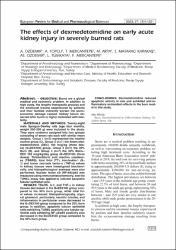| dc.contributor.author | Özdemir, Ayşe | |
| dc.contributor.author | Topçu, Atilla | |
| dc.contributor.author | Mercantepe, Tolga | |
| dc.contributor.author | Arpa, Medeni | |
| dc.contributor.author | Karakaş, Sibel Mataracı | |
| dc.contributor.author | Özdemir, Ali Sezin | |
| dc.contributor.author | Tümkaya, Levent | |
| dc.contributor.author | Mercantepe, Filiz | |
| dc.date.accessioned | 2023-08-11T10:27:42Z | |
| dc.date.available | 2023-08-11T10:27:42Z | |
| dc.date.issued | 2023 | en_US |
| dc.identifier.citation | Ozdemir, A., Topçu, A., Mercantepe, T., Arpa, M., Mataracı Karakaş, S., Ozdemir, A., Tümkaya, L., & Mercantepe, F. (2023). The effects of dexmedetomidine on early acute kidney injury in severely burned rats. European review for medical and pharmacological sciences, 27(4), 1311–1321. https://doi.org/10.26355/eurrev_202302_31365 | en_US |
| dc.identifier.issn | 1128-3602 | |
| dc.identifier.uri | https://doi.org/10.26355/eurrev_202302_31365 | |
| dc.identifier.uri | https://hdl.handle.net/11436/7969 | |
| dc.description.abstract | OBJECTIVE: Burns are a global
medical and economic problem. In addition to
high costs, the lengthy therapeutic process and
the emotional trauma experienced by patients
and their families indirectly worsen the socioeconomic damage caused. Kidney failure observed after burns is highly correlated with mortality.
MATERIALS AND METHODS: Twenty-eight
male Sprague-Dawley rats (age four months,
weight 250-350 g) were included in the study.
They were randomly assigned into four groups
consisting of seven rats each with similar mean
weights. Group 1 (n=7) represented the healthy
control group (C), Group 2 (n=7) the Sham+dexmedetomidine (DEX) 100 mcg/kg (three doses) (S+DEX100) group, Group 3 (n=7) the 30%
Burn (B), and Group 4 (n=7) the 30% Burn+-
DEX 100 mcg/kg/day group (B+DEX100) (three
doses). Thiobarbituric acid reactive substances (TBARS), total thiol (TT), interleukin-1 (IL1) and tumor necrosis factor-α (TNF-α) values
in kidney tissues were investigated biochemically, and histopathological analyses were also
performed. Nuclear factor κB (NF-κB)/p65 was
measured using immunohistochemistry, and the
TUNEL assay was applied to indicate apoptotic
tubular epithelial cells.
RESULTS: TBARS, IL-1, and TNF-α in kidney
tissues decreased in the B+DEX100 group compared to the 30% burn group, while total thiol values increased. Histopathologically, atypical glomeruli, particularly necrotic tubules, and
inflammation in peritubular areas decreased in
the B+DEX100 group compared to the 30% burn
group. In addition, apoptotic tubular epithelial
cells exhibiting TUNEL positivity and tubular epithelial cells exhibiting NF-кβ/p65 positivity also
decreased in the B+DEX100 group compared to
the 30% burn group.
CONCLUSIONS: Dexmedetomidine reduced
apoptotic activity in rats and exhibited anti-inflammatory antioxidant effects in the burn model in this study. | en_US |
| dc.language.iso | eng | en_US |
| dc.publisher | Verduci Publisher | en_US |
| dc.rights | info:eu-repo/semantics/openAccess | en_US |
| dc.subject | Burn | en_US |
| dc.subject | Dexmedetomidine | en_US |
| dc.subject | Inflammation | en_US |
| dc.subject | Kidney | en_US |
| dc.subject | Oxidative stress | en_US |
| dc.subject | Rat | en_US |
| dc.title | The effects of dexmedetomidine on early acute kidney injury in severely burned rats | en_US |
| dc.type | article | en_US |
| dc.contributor.department | RTEÜ, Tıp Fakültesi, Cerrahi Tıp Bilimleri Bölümü | en_US |
| dc.contributor.institutionauthor | Özdemir, Ayşe | |
| dc.contributor.institutionauthor | Topçu, Atilla | |
| dc.contributor.institutionauthor | Mercantepe, Tolga | |
| dc.contributor.institutionauthor | Arpa, Medeni | |
| dc.contributor.institutionauthor | Karakaş, Sibel Mataracı | |
| dc.contributor.institutionauthor | Tümkaya, Levent | |
| dc.contributor.institutionauthor | Mercantepe, Filiz | |
| dc.identifier.volume | 27 | en_US |
| dc.identifier.issue | 4 | en_US |
| dc.identifier.startpage | 1311 | en_US |
| dc.identifier.endpage | 1321 | en_US |
| dc.relation.journal | European Review for Medical and Pharmacological Sciences | en_US |
| dc.relation.publicationcategory | Makale - Uluslararası Hakemli Dergi - Kurum Öğretim Elemanı | en_US |


















